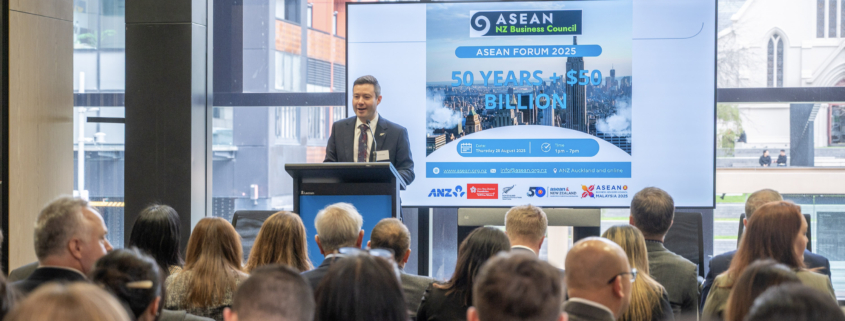Mood of the Boardroom: Geopolitics moves up the risk list (NZ Herald)
Mood of the Boardroom: Geopolitics moves up the risk list (NZ Herald)
New Zealand’s business leaders are sharply aware of the risks posed by an unsettled global environment, with the majority now integrating geopolitics into their governance.
In the 2025 Mood of the Boardroom survey, 78% of chief executives say their boards regularly assess geopolitical vulnerabilities as part of their risk matrix. A further 21% say the issue is not systematically addressed, and 1% say they are unsure.
For many leaders, 2025 has reinforced the need for constant vigilance. “This year has underlined that small nations like New Zealand feel every ripple of global instability and must turn agility into our strategic advantage,” says Institute of Directors CEO Kirsten (KP) Patterson.
For some, the response is systematic. Morrison CEO Paul Newfield says, “At every board meeting, we discuss geopolitics and its impact on both capital flows and investment risks.”
Executives with international reach stress the obvious. “A no-brainer when we operate and are exposed to the Asean, European and the Americas markets,” says Mainfreight managing director Don Braid. The head of an investment firm adds: “New Zealand is obviously very vulnerable when you look at what is happening in Southeast Asia and in the Pacific. This is our region.”
Concerns around China remain central. A chairperson in the food industry observes that “concentration of business in China has been part of our discussion for a decade.”
Education leaders are equally wary. One recognises that “given our reliance on Chinese student recruitment, we have active monitoring and diversification strategies in place”.
The ripple effects of conflict and protectionism are also straining margins. “The impact of global uncertainty, trade and tariffs, and the current wars are causing significant impacts on the rising cost of goods for our business and our customers,” warns a grocery executive.
Even domestically oriented firms feel the knock-on. The chairperson of an energy firm notes that “while our business tends to be domestically focused, we nevertheless keep a wary eye on these factors as they may impact our customers.”
New NZIBF director outlines exporters’ response to tariffs
New NZIBF director outlines exporters’ response to tariffs
The New Zealand International Business Forum (NZIBF) has entered a new chapter of leadership, with Felicity Roxburgh stepping in as executive director at a time of heightened geopolitical uncertainty.
Roxburgh brings almost 20 years’ experience in trade and foreign policy. She has served in senior roles at the Ministry of Foreign Affairs and Trade, with postings in Hong Kong, New York and in the Pacific. Most recently, she was New Zealand’s Consul-General in New Caledonia, and before that led the business programme at the Asia New Zealand Foundation. She succeeds Stephen Jacobi who helped establish NZIBF in 2007.
Roxburgh had little time to ease into the role. Just weeks after joining the Forum she was fronting 15 media interviews on the United States’ sudden 15% tariff on New Zealand goods.
“There is a large appetite to understand what is happening in clear, simple terms and the impact on our exporters,” she says. “People knew the tariffs were going to impact us, but they didn’t know how or why.”
One of her top priorities is ensuring the fast-moving responses of business are better understood.
“Companies are responding to tariffs, supply chain disruption and investment uncertainty in real time”. Whether through scenario planning, diversifying into new markets or passing on costs to importers and consumers, she says these real-time adjustments are often invisible in high-level policy discussions, yet they are vital for resilience and competitiveness.
She is also focused on the future of New Zealand’s free trade agenda. Roxburgh points out that while New Zealand benefits from a dense “elaborate spaghetti network of free trade agreements”, gaps remain. “India and the US are the big missing pieces,” she says, noting that the government is putting huge investment into growing the India relationship and negotiating an FTA.
“At the same time, behind-the-border barriers — non-tariff costs — hit our exporters up to $10 billion a year. It’s a huge challenge.”
She also sees real opportunity in major trade blocs deepening collaboration. “If the Comprehensive and Progressive Agreement for Trans-Pacific Partnership (CPTPP) and the European Union were to do something together — and with us being a member of the CPTPP — it would be around 30% of the global trade. That’s one to watch.”
For Roxburgh, NZIBF’s role in the current climate is clear: to amplify exporters’ experience and work with the Government to push forward on market access.
“What does a business response look like to geopolitical uncertainty? Scenario planning, diversification, pricing changes, working with partners. These are practical steps companies are taking, and that’s the story we need to tell.”
New Zealand ASEAN Forum (ASEAN New Zealand Business Council)
New Zealand ASEAN Forum (ASEAN New Zealand Business Council)
What took New Zealand and ASEAN a year in 1975 now happens in just three days: $220m in two-way trade. This week’s ASEAN Forum celebrated 50 years of ASEAN–New Zealand relations, with a bold new goal to double trade to $50 billion.
Minister for Trade and Investment Todd McClay highlighted why this relationship matters, pointing to the complementary strengths of ASEAN and New Zealand across food, manufacturing, education, and tech. Chair of the ASEAN Business Advisory Council for Malaysia, Tan Sri Nazir Razak, framed it in global terms – a “time of monsters” as the old order shifts, where ASEAN must integrate, diversify, and push ahead on digital and trade agreements.
The business panels brought the lessons to life.
Gavin M. Faull (Swiss-Belhotel International) reflected on his five decades of work in the region, saying trust is the most critical currency, alongside cultural understanding and win-win partnerships. Michelle Noordermeer (CarbonClick) echoed this, stressing the importance of being present in-market to build credibility and navigate hierarchies.
Singaporean entrepreneur Jerel Kwek founded Addiction Pet Foods, a New Zealand manufacturer of pet food that exports to the world. He urged Kiwi firms to treat ASEAN not just as a market but as a partner, to move up the value chain, embrace innovation and use technology like AI to overcome complexity and drive growth.
It was great to MC such a fantastic event. Congratulations to the ASEAN New Zealand Business Council for making it happen.
ICBC NZ CEO Bin Liu sees exciting opportunities to finance New Zealand’s infrastructure transformation, writes Tim McCready
New Zealand is entering a critical new phase of infrastructure development. Decades of underinvestment, rapid urban growth, and the increasing impacts of climate change have converged to create both a challenge and an opportunity.
ICBC New Zealand, a subsidiary of the world’s largest bank by total assets and capital, sees compelling potential for Chinese capital to support this transformation. With more than 11 years of local operations, the bank draws on global experience and deep funding capability to deliver tailored, ESG-aligned financing solutions for New Zealand.
Speaking at the recent China Business Summit in Auckland, Bin Liu, CEO of ICBC New Zealand reflected on the state of the market.
“I have three key takeaways from the past year,” he said. “First, we are finally seeing more infrastructure projects moving — and at a bigger scale than before.
“Second, it’s the best time in the history of New Zealand’s infrastructure.
“We know that we have an infrastructure deficit. Everyone can feel it, especially in Auckland.
“But at the same time, for those of us working in the sector, we see the pipeline growing. We see government commitment, real movement, and more deals coming to market. That gives us confidence and opportunities to contribute.”
China’s infrastructure journey offers useful lessons about what’s possible when demand, planning, and funding align effectively. Liu outlines five key drivers that, in his view, have underpinned that success:
“First, decades of fast economic growth following China’s reform and opening-up policy created huge demand for infrastructure.
“Second, there has been strong government commitment and long-term strategic planning, supported by efficient execution.
“Third is China’s comprehensive industry system and skilled workforce. We have an integrated supply chain and a large pool of engineering talent and construction capacity.
“Fourth is our openness. China has consistently looked outward to adopt global technologies and best practices.
“And finally, dynamic funding solutions. We have a flexible and comprehensive financial system that enables sustainable infrastructure investment.”
While acknowledging that New Zealand and China operate in different contexts, Liu believes there are still valuable insights to draw from.
“It’s not about copying models, but about learning what works and adapting it locally. That’s where international collaboration can really add value. I believe there are opportunities for more Chinese expertise, capacity, technology and innovation to contribute to New Zealand’s infrastructure.”
It’s a message Liu has championed for some time. Back in 2019, ICBC helped facilitate a high-level delegation of public and private sector leaders from New Zealand’s infrastructure industry to China, organised by Infrastructure New Zealand. The programme in Shanghai and Beijing aimed to deepen sector-to-sector understanding.
“The connections and trust built between the infrastructure sectors of both countries during that trip were invaluable,” recalls Liu.
“It helped shift perception and highlight the potential for collaboration. That momentum was disrupted by Covid, but with infrastructure needs intensifying it is the right time to rebuild and strengthen those ties.”
Bridging global capital and local ambition
Liu says a useful lens for understanding what is possible is to look at what ICBC New Zealand is already doing here.
“Our focus spans four key areas: infrastructure, such as roads, ports, airports, energy, power and telecommunications; people’s welfare and development, including healthcare, aged care and education; businesses with trade and investment ties to China; and long-term asset development, particularly in property.”
He notes that the level of Chinese capital involvement varies across these sectors, but the opportunities are clear.
“ICBC Group has a presence in more than 49 countries, including flagship branches in major international financial centres,” Liu says.
“We can source funding from different financial markets using economic and efficient instruments. Overseas issuance and money market operations have become a very important part of ICBC New Zealand’s funding mix, allowing us to support local infrastructure projects effectively.”
Liu believes that New Zealand’s infrastructure landscape is poised for real progress.
“We are prepared to finance New Zealand’s next generation of climate-resilient and community-focused infrastructure,” he says.
“We’re not just banking for today, but for generations to come.”
Agribusiness and Trade: New Zealand launches grass-fed standard
- Official standard will increase demand for our products and enhance the credibility of our quality products.
- Producers who meet the standard can be assessed and choose to display a licensed FernMark Grass-Fed logo.
- The standard will be reviewed after one year, and then at least every three years.
New Zealand red meat and dairy producers can now be certified as producing grass-fed meat and dairy under a new standard introduced by the Ministry for Primary Industries (MPI) and launched at Fieldays.
The New Zealand Grass-Fed Administrative Standard provides a formal, Government-recognised definition of what constitutes grass-fed production. Producers who meet the standard can be assessed and choose to display a licensed FernMark Grass-Fed logo, issued by the government agency New Zealand Story.
“Industry has informed the Government that there are customer requests for Government backing of this important attribute in key markets,” says Jenny Cameron, Chief Transformation Officer at the Ministry for Primary Industries.
“By facilitating and coordinating a standard across the pastoral sector, we are able to demonstrate and prove our grass-fed credentials, which will help to maintain or increase demand for our products and enhance the credibility of our quality products.”
Cameron notes that there is significant and growing demand from consumers around the world to know how their food is produced, and to have traceability in the supply chain for products they buy.
“New Zealand can provide that,” she says. “We are proud of the way we farm in New Zealand with high biosecurity, sanitary, animal welfare and sustainable practices. We want to ensure these attributes are recognised and understood by the world.”
New Zealand’s temperate climate, with plentiful rainfall and sunshine, means our dairy and red meat sectors are largely pasture-based.
“This is a key point of difference for New Zealand’s dairy and red meat production, as animals on most other countries’ red meat and dairy farms spend much of the year indoors or eating grain-based diets,” says Cameron. The standard applies separately to red meat and dairy, and is designed to strengthen international market access and validate New Zealand’s long-standing pasture-based farming systems.
For dairy, the standard requires that animals spend at least 340 days per year, for at least eight hours per day, on pasture or forage crops, and have a diet comprised of at least 90% qualifying grass-fed feed.
For red meat, animals must be predominantly fed grass-fed feed types and be permitted to graze outdoors on pasture or forage crops year-round. Feedlots are not allowed, and animals must be removed from pasture or forage crops only for animal management purposes or to safeguard them or the environment from adverse events.
The new standard is voluntary, and there is no requirement for red meat or dairy producers to use it, but MPI says it expects it to become a valuable tool for differentiation.
“We anticipate that China is a market this will be particularly relevant for, but we also know other markets have customers and consumers that make choices based on grass-fed or grain-fed for their own or family consumption, as well as for pets,” says Cameron.
“Only about 10% of the world’s dairy is grazed on pasture, and New Zealand has the greatest time outdoors of any country.”
An independent review commissioned by MPI compared the New Zealand standard to similar international frameworks in Ireland, the United Kingdom, Canada and the United States. It found New Zealand’s requirement for 340 grazing days for dairy is higher than that of other standards.
The development of the standard has involved wide industry consultation. Cameron says dairy and red meat companies have been a part of the development of the voluntary standard, and have been strong proponents for it.
“Since the launch at Fieldays, we have received positive feedback from farmers and industry as a whole,” she says. “As of 27 June, we have had three grass-fed schemes listed as meeting the standard: Fonterra, Spring Sheep, and Westland Milk Products.”
The standard will be reviewed after one year, and then at least every three years, to ensure it remains fit for purpose as environmental and market conditions evolve.
Agribusiness and Trade: Sustainable food innovator seeks inspiration from NZ
Ray Poh from one of Singapore’s leading vertical farms talks with Tim McCready about what he can learn from New Zealand’s agriculture sector.
Artisan Green, founded in 2018 by Ray Poh, is a high-tech, indoor farm that uses stacked growing systems, precision automation and plant science to produce pesticide-free leafy greens in the densely populated city-state.
Poh didn’t start out in agriculture. After years working in the casino industry in Macau, he returned to Singapore looking for a new challenge that was meaningful and sustainable.
That led him to vertical farming, a sector combining climate-controlled growing environments with data and automation. With no prior experience, he began experimenting on a small indoor site with practical knowledge gained through site visits and workshops in Japan and Australia, and volunteering at other farms.
Now, Artisan Green is the country’s top producer of baby spinach as well as other leafy greens and herbs.
In land-scarce Singapore, space is precious. But so is food security.
Singapore imports more than 90% of what it eats, however, as part of its “30 by 30″ goal to produce 30% of its nutritional needs locally by 2030, the Government tenders parcels of land for agriculture. Artisan Green won its plot by demonstrating the commercial viability and technical sophistication of its operation.
From its original 300 square metre facility, the company is preparing to move into a new two-hectare site in Singapore’s designated agriculture zone. The expansion includes a 5500sq m vertical farm, along with significant outdoor greenhouse space and a 4000sq m facility to support post-harvest operations.
This will lift production from one tonne a month to 30 tonnes per month in the initial phase. The second phase will see this increase to 90 tonnes per month.
Poh says the larger scale will allow Artisan Green to bring prices down and make the locally grown produce more competitive.
“Our aim is to price between overseas imports and imported organic produce,” he says. “People support us even though we’re more expensive than imports because we’re local, and our customers – especially younger families – want to avoid exposing their children to pesticides.”
In partnership with Siemens, Artisan Green has digitised its crop recipes: water and nutrient profiles, lighting cycles and temperature settings, allowing consistent yields without relying on a large team of plant scientists.
“We encapsulate the entire growing cycle into our recipes,” he says, “which means that anyone using this platform in the future will not have to be a plant scientist to operate it.”
Poh explains that the intellectual property developed will help make future expansion easier. With the science centralised and scalable, Artisan Green can replicate its model overseas using local workers, without having to bring in expensive technical talent.
He likens it to McDonald’s. “You don’t have chefs in McDonald’s. You just need operators, while all the R&D is done in the central kitchen.”
Poh was in New Zealand last month as part of the Asia New Zealand Foundation’s ASEAN Young Business Leaders Initiative programme.
The delegation of 11 agribusiness entrepreneurs visited businesses around the country and attended Fieldays to learn about New Zealand’s agricultural sector, build local connections, and explore future business opportunities.
Poh says that for a city-based grower like him, seeing how New Zealand brings together science, industry and government in the agribusiness sector has been eye-opening.
“Agriculture is in New Zealand’s blood,” he says. “It’s not just individual farmers doing their own thing, you can see how industry and government work together to advance the sector.”
He points to New Zealand’s plant science research and downstream operations, including packhouses, marketing, and distribution networks, as areas that Singapore still needs to develop.
Too often, he says, small farms in Singapore fail not because they can’t grow food, but because they can’t get it to customers efficiently. It’s one reason why Poh started his own distribution company, which now handles produce from other local farms as well.
There are lessons New Zealand might take from Singapore too, particularly the value of investing in science to develop high-value crops that can command a premium.
“We can’t grow things like baby spinach outdoors in Singapore. It’s too hot. So we grow it indoors. But to make that work, you need margins, and you need to grow something premium,” Poh says.
And you need to know your science.
“A lot of people think AI or automation is going to revolutionise agriculture. But you can’t eat software,” he says.
“So you need to know your basics in plant science first, then automate from there.”
Poh sees both countries as coming at the same problem from different angles. New Zealand has deep-rooted farming knowledge and strong science institutions. Singapore brings innovation in urban food production.
If the future of food is global, then the best ideas will likely grow in both places.
China Business Summit 2025: Prize Draw
Prizes courtesy of Air New Zealand and Silver Fern Farms
Katy Riddell, Summit Event Director
Sam Winstanley, Senior Manager Corporate, Government & SME Sales, Air New Zealand
Tim McCready, Summit MC
The 2025 China Business Summit was held on 18 July 2025 at Cordis, Auckland.
Brought to you by NZ INC. and Auckland Business Chamber.










